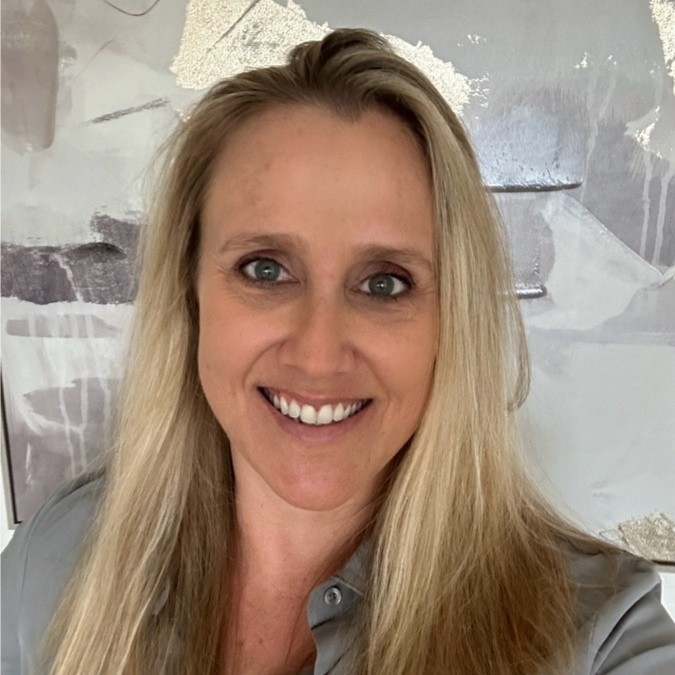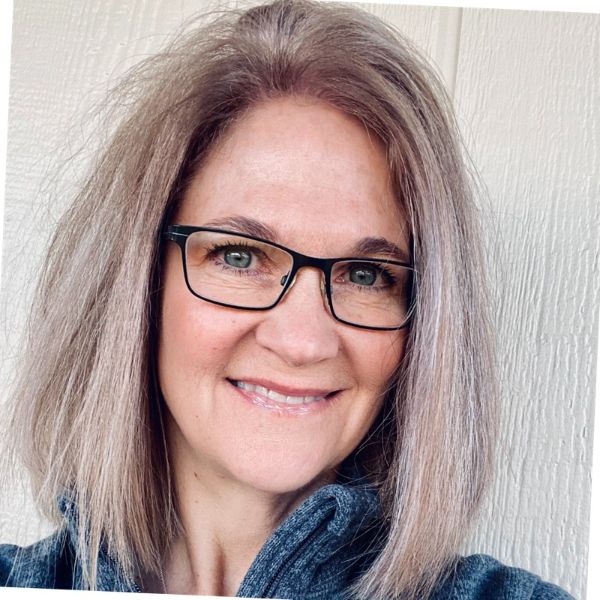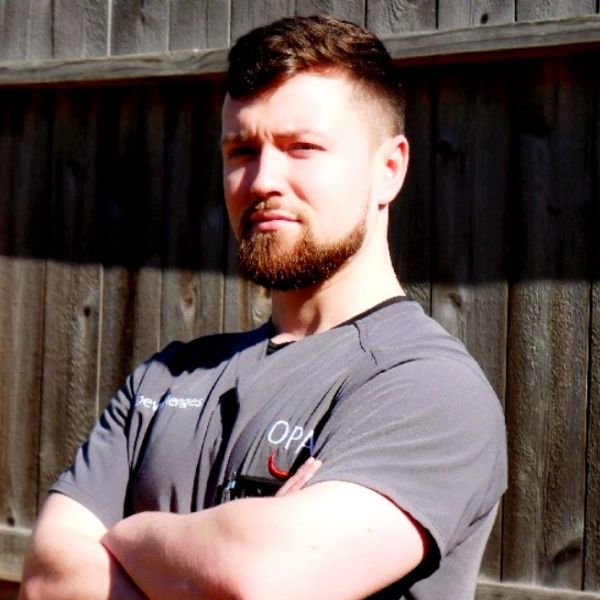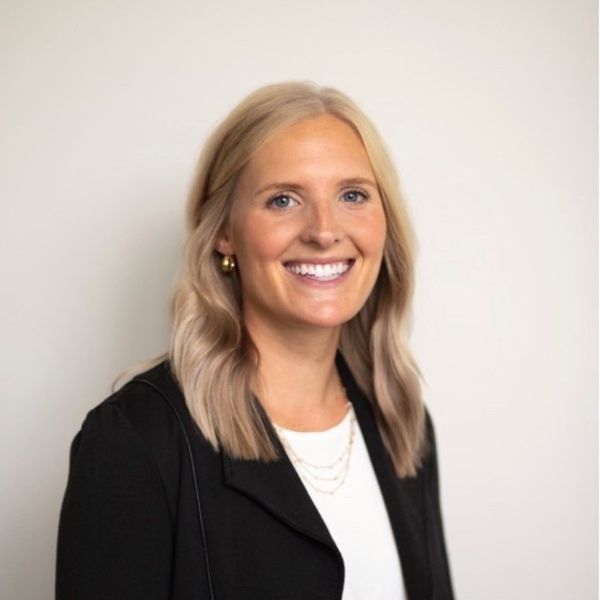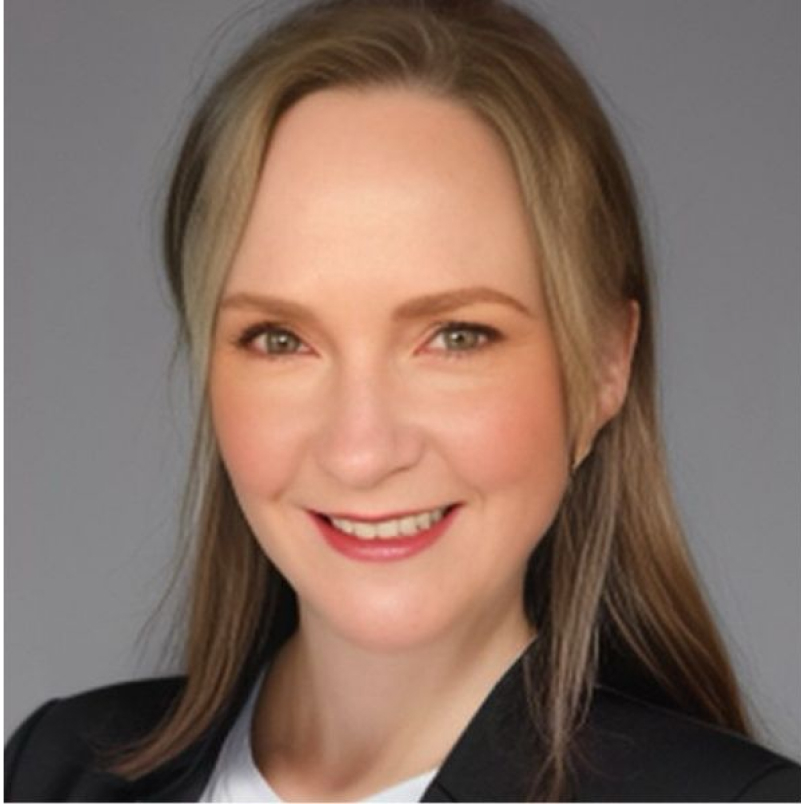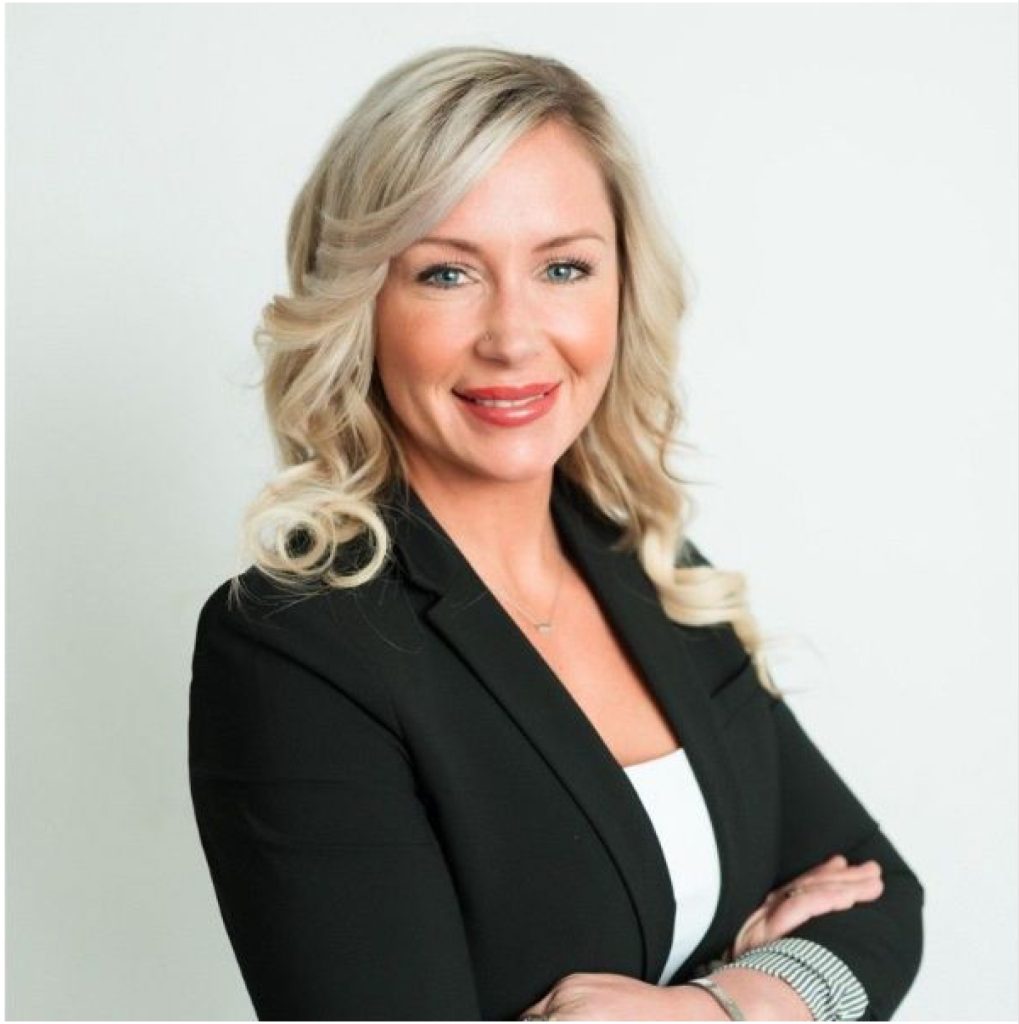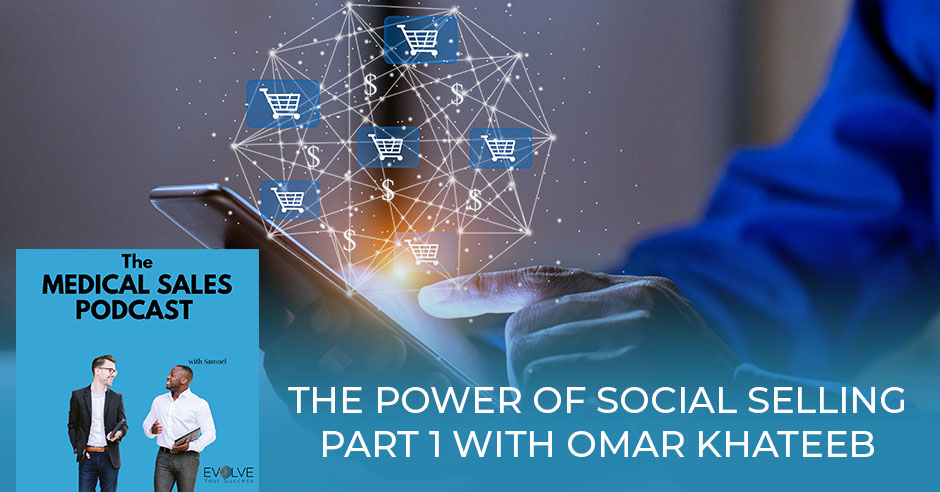
Are you already on social media? If you’re not, you need to be, especially if you want to build stronger relationships, identify better prospects, and hit your sales goals! Today, Omar Khateeb and Samuel Gbadebo dive into the value of social media selling in the healthcare sales space. Don’t get left behind. Discover the power of social selling and learn what building a brand on a platform can do for your territory, team, and career.
—
Listen to the podcast here
The Power Of Social Selling Part 1 With Omar Khateeb
We have a special episode. This was an interview I had where I was the guest on Omar Khateeb’s show, The State of MedTech. He and I had a discussion around the power of social selling. He runs an organization that helps medical sales reps grow in their careers and develop a brand through social media, as we hear it evolve as success. We have a very robust discussion around the impact social selling has had in the healthcare space and what it has done and still can do for the medical sales rep. As always, thank you for reading and I do hope you enjoy part one of this episode.
—
We have a very special guest. He’s been a friend through LinkedIn for a while. I learned that he’s in the same region as me, like 20-30 miles away, which is wild. Who would have thought two talented medical sales, coaches and trainers are that close to each other? I guess that’s the way the world works. I’m going to bring on my good friend, Samuel Adeyinka.
How are you doing, Omar?
It’s been a long time coming, but at some point, this had to happen. How are you doing?
I’m doing fantastic. This did have to happen. It has been a long time coming. I’m glad to be here.
We have an interesting agenda in this episode. Samuel and I talked, and the biggest thing we want you to walk away with is, at a minimum, you’re going to walk away with three good ideas that you can implement the next day. You don’t even have to wait until the next day. I’d say implement them while we’re talking. We’re going to cover these three topics. I asked Samuel to think through, like, “If you were to impart some actionable advice to these salespeople and leaders, what would it be?”
We’re going to cover those three topics, but then we’re also going to do a little bit of fireside Q&A. Samuel, I’m going to bring up the three key topics that we’re going to be discussing one at a time and let’s go through each of them. The very first thing we’re going to start with is Samuel, talk to us a little bit about what you think some of the most important parts of your profile are.
The profile is a critical piece because it’s where you sell. Everything on your profile is where you can be crystal clear about the service you provide and exactly who you’re talking to, from your picture to your background to your title and through your about section. It’s where you can make it as colorful as you want it to be. Be as clear as what you provide and also give a little bit of personality. You can do all that from your profile page. It’s the only place that you should be selling from until you have a large enough audience.
[bctt tweet=”When you’re putting out content, a.k.a. posts, your whole goal should be to provide value for your audience.” via=”no”]
Why should that be the only place you should be selling from? Why is that an important thing for people to know?
The reality is when you’re putting out content or posts. You’ll see some people selling, some people not, but your goal for your audience is to provide value. LinkedIn is like a super amped search engine. People are looking for whatever they can find, but it’s all coming through the feed. The last thing you want to do is be new on the platform. Start pumping out content and start selling right away because it’s immediately going to turn people off.
It’s like those marketing messages that you’re getting all the time in your inbox. Most of them, you’re not even taking a moment to read. When you see that post that’s trying to sell you something directly, even if it’s for you, a lot of times, you’re not going to take a second to read it because you’re going to assume it’s more spam or more marketing messages. Your goal should be to provide value with all of your content. When you provide that value, truly interested people will go to your profile to seek you out, then you can sell them what it is you’re doing for them and the value you provide.
It’s a very good point. I wonder how you feel about this. By the way, for context, Sammy and I talked about some of the key topics. We didn’t rehearse any of this, so this can go anywhere in any direction. That’s the value of going live. Samuel, one of the things I wonder is that while I love LinkedIn, I feel that what they don’t do a good job of is they optimize more for tools that are good for spamming people. I feel like the benefit of that is that it makes it easier to stand out when you add value because so many people, especially in sales, go straight to, “I’m going to use automation. I’m going to hit their inbox up, etc.” Would you agree with that? What do you think?
I think LinkedIn tries to prevent spamming tools. Maybe a few years ago, they were heavily used. People’s using video, of course, but LinkedIn started cracking down on spamming tools. What’s more important than that is what works is organic reach. Even if you’re brand new on the platform, you got less than a thousand followers. You’re putting out valuable content that your audience received. From what we’ve seen, that’s going to grow you faster than almost anything, to begin with.
Ultimately, you can get into the paid ad and things like that, but to begin with, good organic value. LinkedIn is going to propagate the heck out of your stuff and get it in front of as many eyes as possible. That, again, supports what we’re talking about now. Your goal shouldn’t be to sell. Your goal should be, how can I best inform my audience and give them something they can use, utilize, something that they need and give it to them in a snippet.
A lot of people don’t necessarily go to sit down with a long article or a long post about some other things. Enough information so they can take them bite-sized information, so they can take and say, “I’m going to try and apply this now and maybe even get some results.” It will bring them back to see what you’re going to pump out next.
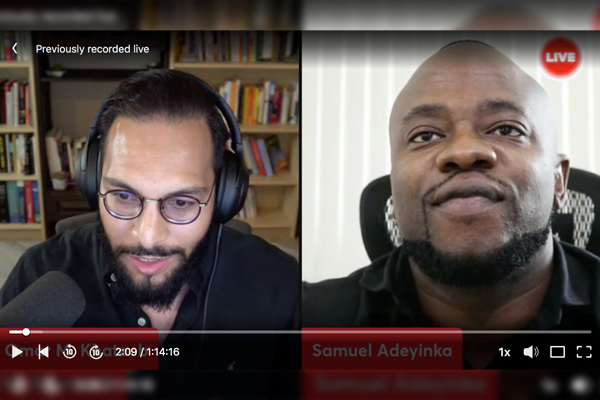
That’s a good point. Something that I’ve noticed. Outside, even medical sales, when I look at some of the top creators on LinkedIn, like my friend Justin Welch, a lot of people know him as the big solopreneur on LinkedIn. He’s got 250,000 followers. He’s even said it himself that he sees a massive decrease in engagement. The moment he tries to sell something, which there is a time and place to do that. The best time for selling is when you’re providing value for free. A lot of times, it doesn’t have to do with what you directly sell. People can get value from you from leadership articles.
Physicians are no different than medical salespeople. They work with other people. They have leadership positions. They’re trying to be more productive. A lot of times, if you’re able to share things that you’re learning on the job, even something simple as, “Here’s how I like to start my day or here’s how I manage a tough situation at work.” Physicians or whoever you’re selling to will learn from you indirectly. They’ve now technically bought a free product from you with their own attention. It makes it easier for them to move forward to something like buying a “meeting with you.”
I think what you’re highlighting is having visibility. What gets you a lot of visibility is, like you said, again, providing value. One thing, just speaking to what we talk about. We’re talking about social media selling almost specifically for medical sales reps. The reality is that social media selling can work for any type of sales rep in any industry. When it comes to medical sales reps, people can say, “I got to make sure my content is only appreciated by whatever type of doctor I’m trying to get in front of. I’m going to make this type of content.” They don’t get a lot of traction. They wonder what they’re doing wrong.
To the point you were talking about. As a medical sales rep, you want to talk about everything you’re experiencing as a sales rep in addition to the value you’re providing for the surgeons, physicians, or healthcare administrators. You want that full picture. A lot of sales reps are following you too. They can identify with what you’re experiencing. The healthcare providers connected to them will also see those same posts. When you’re engaging in whatever they’re putting out, it’s all going full circle and it gives you that much more visibility. That should be the goal for the sales reps. How can I provide value while getting maximum visibility?
I think whether you’re in a huge corporation like Johnson & Johnson or Medtronic or even a startup. When you have, let’s say, a new product. If you think of technology adoption, every adopter sits at a different point. Some people like to adopt things very early and they’re okay with it being new because they like that. There are other people who sit farther on the adoption curve. It doesn’t matter what it is you’re selling or marketing. They need to see certain things.
It could be that day, that week, that quarter, they’re not at that adoption phase as a cycle, but they can passively and actively watch and engage with you, be endeared to you, be persuaded by you and see that adoption happening. When you do reach out at the right time, it could be the day that they say, “This problem has become too painful for me. I’m going to meet with this person.”
You nailed it. I think another thing that I would throw in there with what you’re saying is that the most important thing someone considering social selling can do is get comfortable putting themselves out there on the platform, the reality of how many touches it takes to impact someone’s behavior. A lot of people reading are sales reps. They’ve experienced this before.
[bctt tweet=”When you’re putting out valuable content that your audience received, that’s going to grow you faster than almost anything, to begin with.” via=”no”]
They understand that a little bit, but there are so many touches it requires and because our attention spans are only getting shorter. It’s only becoming more touches to get someone to say, “This is for me.” If you can get in the habit of putting out content now or at least reposting with putting your two cents on what you’re seeing and get that consistent. It’s going to be a lot easier to drive someone to want to seek you out for your services in the LinkedIn platform.
Going back to important parts of the profile, I think we would both agree that the first thing a lot of people don’t even realize, even doctors until a patient mentioned it to them, is to go to your privacy settings. Make sure that your profiles are visible to people even if they’re not logged into LinkedIn because people will look you up.
If you do something where you leave a good comment on a post or you have a great post that other people see. If that’s that moment that a doctor or a decision-maker or maybe even a company CEO decides to click your profile, they go and they’re blocked because you’re not a connection. There’s not a high chance they’re going to come back.
It’s funny because when I work with companies that have medical sales teams and we work with their sales reps into getting them to throw out brands on this platform. I get a lot of mixed reviews. I get some people that say, “If I allow all these physicians to see me any time, then they’re going to know that I’m looking at their profile.” It almost goes in the face of what we’re trying to do. I want to put something out there with what you said. When it comes to visibility, if you’re going to take on using LinkedIn as a place to sell, improve your sales and spread more knowledge to your audience, you’ve got to ask yourself, “How comfortable do I want to get?”
If you want to go all the way, then you should be wide-open to making yourself as available as possible, with full visibility. Anyone can search you. Anyone can find you. One thing we could even say now that might not be common knowledge is your URL. Your name should be so easy to find that if someone typed in your name and the company you work for, your LinkedIn profile is the first thing that pops up on a google search.
The way you create that is simply changing your URL to erase all numbers and only having your first and last name. If your first and last name is taken, maybe your first name and the middle initial then your last name. Something that makes it crystal clear that this LinkedIn profile is your space. Anyone can find it from anywhere if they’re so inclined to. Get comfortable with that. As Omar said, make sure all the visibility settings allow you to be seen. Your pictures should be seen. One of the things I’m sure we’re going to talk about in a second is how imperative it is to have a picture that speaks relatively well of who you are and get in the habit of, “If I’m going to go this route, anyone could find me at any time.”
We have a good question from Christina Asai I’m going to highlight. Her question’s a great one. The question is, “I would love to hear from Samuel about what advice he would give to those who feel like they aren’t great writers or struggle with finding time to create content and engage with others. They’ve been writing posts versus commenting on other posts. If you had to choose one to focus on, which would you advise to somebody wanting to build their thought leadership when they have a very small following?”

That’s a great question. Sammy, let’s start maybe with the first one, which is people who struggle with finding time to create content versus engaging. I have mixed feelings about this. I don’t even feel comfortable picking one, but this would be interesting. If you had to pick one, if it was a medical salesperson and you had to do one thing for a whole month between posting and commenting, what would it be?
I’m going to sound like I’m deflecting, but I’m not. It does. You have to consider this. It depends on what the goal is. Let’s come up with two scenarios then we’ll get into it. Let’s have this scenario of I want to be a medical salesperson. Maybe I’m not in medical sales yet and want to get into medical sales, or I’m a medical salesperson who wants an entirely new role. Maybe in a different organization or something like that.
If you’re in either of those buckets, engagement is critical because, as we talked about, visibility is king, but if you’re trying to get into a position, then you want to be mindful of the content you push out. You want to focus on getting visible with people that are already visible on the platform. Also, I’ll say that your profile becomes a big piece of this too. If you’re someone trying to get into a medical sales position or get into a new role, then engagement is king. You want to make sure that your profile is tip top.
What’s going to happen is when you’re commenting on other people’s stuff, engage with other people’s posts and leave valuable comments, “That was great. Good job,” but something meaningful. Maybe a response you had or a question you have around what they posted. It’s going to cause them to want to look at your profile. If you’re trying to get a position or you’re trying to get a new position, you’re selling yourself, so you want your profile to be tip top and bring attention to your profile that way. I know that was a roundabout way of answering.
Salespeople are very sharp and they ask me this all the time, like, “Which one should I do?” It goes back to whatever your goals are, even years ago. My background was I carried the bag and I sold for years, but then I also did marketing. Many years ago, marketing to people, even in eCommerce, was a lot more direct and simple. You can drive people to a landing page and convert them there. The buyer has become more sophisticated, so it’s no longer, “Which one’s your growth lever?” That doesn’t exist anymore, especially in B2B.
It’s the same thing case in this way. I think the goal, at least when it comes to LinkedIn, is what do I do with intention, authenticity to provide value, to get someone to lean in and get more curious and go back to my profile? Once they’re on the profile and at least I’ve experienced this micro, maybe the first couple of times, they might read your headline. Maybe your about section. You post some more things. Over the coming weeks, they get more curious. Maybe they go back. They read, go look at some of the articles you wrote. Maybe their recommendations.
The whole point of this is that over time if you consider your LinkedIn page like a product page, you’re a product. You’re being hired to solve a problem. Little by little, that person is going back to your page and looking for the things that they need to persuade themselves to say, “I need to hire this person to solve my problem.”
[bctt tweet=”The most important thing someone considering social selling can do is get comfortable putting themselves out there on the platform.” via=”no”]
To answer that question, my advice would be if you’re trying to get a position or a new one, like Omar said, you want something to come back to your profile. Engagement is the safest way to go. If you spend time on your profile, that’s a very effective way to go. I know this wasn’t asked. If someone’s confident in your writing skills and you’ve posted before, then even if you’re looking for a position.
Posting could be a way to go, but a lot of people are leery about that, so engagement comes first. If you’re trying to develop a brand, though, as a sales rep, you’re trying to grow a brand within your field, then you will need to engage, but posting is by far going to be the most effective thing for you. I keep saying sales rep but for any position.
One of the things I want to mention from Christina is whether it’s God or the universe, whatever you want to believe in, there’s something about when you put yourself out there. When you’re a little bit vulnerable, good things happen. There’s this saying and I think in many religious texts, the fool is the precursor to the savior. I sucked at making videos. I was terrible at writing. I still think every other week, there’s a post I put out, there’s a grammatical error. These things happen.
I would say practice more publicly and start reducing your embarrassment. Get to a point where you’re not embarrassed by anything is a superpower. Believe me. Samuel knows this because we’re both not only entrepreneurs, but we’re solopreneurs. Any given week, we make like 5 or 10 different mistakes. It’s like, “That didn’t work out so well but whatever.”
When you get over that gut reaction of getting one reaction on your posts versus getting 200 reactions on your posts, when you become indifferent to that, you’re starting to move along. Don’t get it wrong. You want to pay attention to your metrics and in segments, periods of time, you want to evaluate why certain things are happening and be more effective in one direction or another.
I think in totality, people coming in care so much about what if I only get four reactions, then no one’s going to want to look at my stuff. They’re so apprehensive about putting those out there. I would say your first notion should be the opposite of that. Put yourself out there as soon as possible. Try not to say anything too inflammatory. If you have to ask if you’re offending someone, you’re probably offending someone. Keep those two rules. Put some content out there. Take some posts that are already out there. Put your own commentary on them, repost them, and start putting yourself out there and get comfortable with it. Before you know it, you’ll be able to harness much better content.
I think once you put yourself out there, you never know who’s watching. I have almost 30,000 followers at this point. I had a post that I thought was good. I got five likes on it. It’s like, “Whatever.” Here’s the other thing. Sometimes what you lack in quantity, it gets made up in quality. Some of my earlier articles in my career, where I put a lot of effort into it, not a lot of people engaged with. The right people did specifically like a VP or CEO. I was like, “That person who I admire and look up to liked my article. They commented on it.”

The benefit of that is with all this information coming, put some genuine thought and a little bit of effort into saying, “How can I leave a thoughtful comment?” If you notice, a lot of surgeons are posting their cases. If anybody comments on the post, it’s like, “Great case.” Take a little extra time and read the comments that other surgeons left, which you can learn from.
Read the post itself, then think, “A lot of these surgeons are commenting the same thing. Let me ask about that in the form of a question and tag the person.” You’re going to feel like a million bucks when you wake up the next day and the chair of surgery is responding to your comment. I see it happen all the time.
Honestly, that’s what it takes. When you can get visible enough or ask provocative questions that get the surgeon going and make them say, “No, I’m going to respond to that.” That’s all it takes. One or two surgeons doing that, then you’re going to be seen as someone that maybe they’re going to ask more response-worthy questions.
If you’re consistent with that, then people start to expect you on the platform and expect to engage with you. That’s where you want to take it at being a sales rep. You want your posting going on one hand and you want that engagement to be expected on the other hand. When you marry the two, you’ll start to see yourself grow as far as your brand.
Before we go to our second topic, I want to highlight another great comment from Vanessa. She says, “Yes, Samuel. I love what you said.” Thank you, by the way. “Thoughts become things and the universe will bring you more confidence as long as you believe in yourself, then business comes after.” It’s as cliché as that sounds. I say that all the time. I’m like, “Your thoughts will manifest what ends up happening.” It’s so true.
If you go out on this platform, anything in life but let’s focus on LinkedIn. You put out a post expecting like, “No one’s going to like this. Whatever.” You’re going to bring that same energy to when you create another post into the comment, then your mind is subconsciously looking for ways that it doesn’t work and you give up. That’s what 99% of people end up doing. The 1% who don’t do that have their careers changed through this platform. This is a very powerful platform.
One more, remember what I said that doctors do jump on this. Here’s a practicing spine surgeon and a rising star on LinkedIn. I’m sure he’s going to be like, “Why’d you do that?” Dr. Michael Verdon, a practicing spine surgeon, “My point is that LinkedIn is not M&M. That’s morbidity and mortality or look at me. Rather, what I can thoughtfully add to the conversation.” I agree, Dr. Verdon. That’s a good segue into our next point. Samuel, what do we need to know about what and when to post? Why is this important?
[bctt tweet=”One thing that people want to see when it comes to these social media platforms is a personal touch. That’s what allows you to get some traction.” via=”no”]
It’s pretty straightforward. I’ll start with when. As far as when to post, it’s when you think your audience has the best chance of catching what you post. Relatively speaking, earlier is better, but with that being said, sometimes your sweet spot could be 10:30 compared to you posting at 8:30. I think one thing that people don’t take into mind is a lot of thought leaders post first thing in the morning. You’re competing with those thought leaders to get content out. You might want to spread your content an hour or two a little bit later. Catching them before lunch is always a smart time to catch people as well.
As far as what to post, this goes back to what you’re comfortable with. If you’re not comfortable posting your own original content, I highly recommend you start looking at what you like. Any posts you like and put some real serious commentary on it. I don’t mean responding with a comment. You can do that too, but I mean, putting your own spin on what you think of whatever it is you like and then reposting it. That’s one way to get yourself out there. Get comfortable with putting out content.
I completely agree with that framework. You said to put thought in the comment but then also reposting it. Walk people through that real quick.
Let’s say you find a post about the journey of a very specific type of medical sales rep. In that post, the rep talks about the relationship they have with the providers. It talks about the service they bring, why they do what they do. Go ahead and put your own two cents. You’re almost saying the same similar responses but with your own experience. I completely agree with this. This is what I do when I’m thinking about why I wake up every morning and go out and do what I do as a sales rep.
Put your own spin. Don’t make it too long. Three or four points, then post that out as content. It recognizes the person who wrote the original piece and then gives your opinion on what you think of their original piece. It also allows you to reach out to them. You can even put @TheirName, then that person is going to be notified that you commented on whatever they were saying. You can still comment on their original post. Think about what this is doing. It’s giving you a lot of visibility and removing the burden of, “How do I make original content?” That’s the first thing I’d recommend and hopefully, that was enough to walk through that framework, Omar.
A lot of times, when people think about posting making content, they look at the whole staircase in front of them versus what you and I are advocating for. It’s like, take one step, comment, reshare posts, put your spin on it and this comes with practice like anything else. If you’re posting, for example, only once a week, that’s going to be four times a month versus, if you say, “I’m going to make it a point. I don’t know what it is. I’m setting 30 minutes in my calendar every day. I’m going to post something every day.” Rather than waiting a month to post four times, you can post four times within a few days.
That’s a good one. I’m glad you brought this up, Omar, because this can get tricky. First of all, I agree with you. You post more and you’re giving yourself more opportunities. However, I’m sure you’ve seen even thought leaders that crack out anything every single day. We’re like, “What’s going on over there?” I would love to add this to what you said because I think it’s good to keep in mind. If you only have the time to post once a week, we’ve seen people go from no followers to 5,000 followers posting once a week. It can work for you. Will you need to put more thought into your content? Yes. Will you want some established credibility somewhere else, whether it be the title of your position of the company you work for? Yes.

If that is all you can give, by all means, give it. Now, if you’re scrambling through and you’re looking for stuff to post any given day, if you know it’s going to provide value, post it. However, if you’re unsure of the value or you know you don’t have anything of value to give at that time, I’m not sure I would say force yourself to pump out something.
I think committing to doing to the discipline. That’s why I tell people, I’m like, “Put it for 30 minutes,” because if it’s like five or ten minutes, you’re going to look for something random and do it. Thirty minutes at least gives you enough time to think through. Here are some simple tips that I tell people. Let’s say you’re in a minimally invasive surgery. Go to Google Alerts, set it, which is an alert that Google sends your email.
For minimally invasive spine surgery, anything that comes out article or news-wise could be delivered to you daily or weekly. You’ll see all the articles, headlines, or publications that week and the whole internet related to middling days of surgery. Not only you’re educating yourself and you’re curating content. If you think about it, for those who are big on Instagram, the big Instagram pages, a lot of them got big not by creating any of their own content. They got very good at curating things.
Do you know Becker’s Spine? Becker’s Spine and Becker’s Hospital is s a big publication. They have a massive publication. Eighty-ninety percent of their publication is literally curating other articles. They summarize it. Their email blast is one of the best email blasts I’ve subscribed to. All it is like top ten things and they’re curating content. That’s all it is, but it’s valuable.
One more thing I’d add to that, too, in addition to posting content like that because that’s hard value. No one can go wrong with that type of content. One thing that people want to see when it comes to these social media platforms is a personal touch. I think that’s what allows you to get some traction on LinkedIn because you can add a personal touch into every one of your posts. One thing I can say for all the medical sales reps reading is it’s allowed if it’s compliant and everything like that. Whenever you’re at an event with your company, take pictures. Get in the habit of taking more pictures.
Maybe you’re comfortable with having yourself be seen a lot on the platform but not everyone is. I’m serious. Even I don’t put a lot of pictures of myself on this platform. Our clients do, but I don’t. A lot of people don’t mind putting themselves out there and putting a pitch on the platform. If you’re one of those people, if you’re comfortable with it, take pictures. Make it a habit to take pictures when you’re out.
A personal touch doesn’t mean you have to say, “I was at this event. It was great. Here’s a picture of me and all of my coworkers.” You can have that picture of you and all your coworkers, but you can put something else. A different type of content. “Attending this event showed me these three things or reminded me of these three things or reminded me that when it comes to this type of provider, these three things are so important.”
You’re taking valuable textual information and putting this personal touch on it with your picture and your team’s picture. That’s the personal touch we’re talking about. It’s not about putting all kinds of Facebook content. Every time there’s a birthday or a baseball game. That stuff’s cool, too, but you can still put a personal touch on.
—
That was part one, the Power of Social Selling, my time as a guest on Omar Khateeb’s to show the State of MedTech. Now, why am I providing this to you as my audience? It’s because I want you all to hear how impactful social media has become in the healthcare sales space and what it can do for you and your career. It’s one thing to hear it from me over and over again. It’s different when I bring in another thought leader that works in the same space and you hear from both of us what we’re seeing, what’s happening and the results are creating for people.
That’s why I’m bringing this to you. Make sure you tune in for the next episode of the Power of Social Selling Part Two. Some of you might be reading this and you’re thinking about getting into this industry. Don’t think about it anymore. Take action. Go onto our website of EvolveYourSuccess.com, select Attain Medical Sales Role, fill out that application, schedule the time and let’s have a conversation. Either myself or someone from our team is going to have a conversation with you around how to get you where you want to be and get you into this field of health care sales.
If you’re someone in the healthcare sales space, maybe you want to deliver for the rest of the year. We have time to make some serious impacts, serious gains and you want that to be you. Go to EvolveYourSuccess.com and select Improve Sales Performance. Lastly, this is for everyone. It doesn’t matter if you’re a leader in the healthcare sales field, if you’re a rep or if you’re anywhere in between. It doesn’t even matter if you’re someone trying to get in. Social media has become a platform that can be leveraged and should be leveraged to develop a brand for yourself.
Why not take advantage of that opportunity? The opportunities are here. It’s now and you can do something with it. If you’ve been thinking about it or even wanting to, but you’re not quite sure what to do and how to do it, then again, visit EvolveYourSuccess.com. Go to improve Sales Performance and select our LinkedIn Program.
Have a conversation with someone here at Evolve Your Success and let them channel you to what will change and could potentially change your career. Definitely change your performance and give you a completely different experience within your position. As always, we do our best to bring you guests that have insight, to bring information that is compelling and thought-provoking and to bring your resources that can change your life. Make sure you tune in for the next episode of the Power of Social Selling Part Two.
Important Links
Love the show? Subscribe, rate, review, and share!
Join the Medical Sales Podcast Community today:

